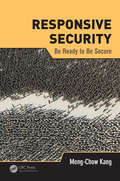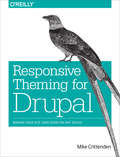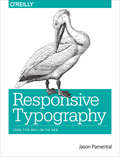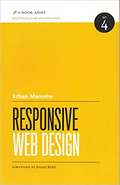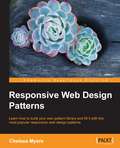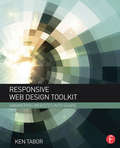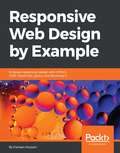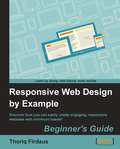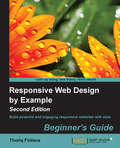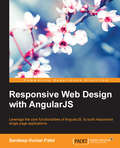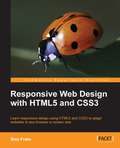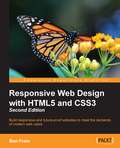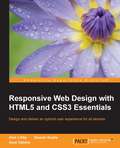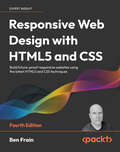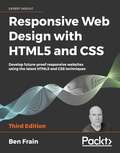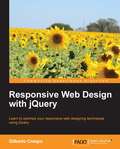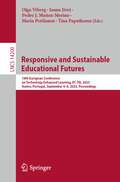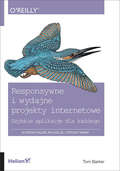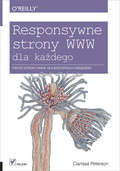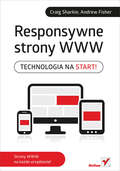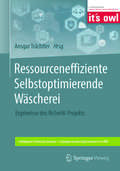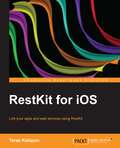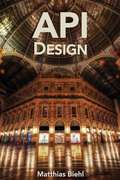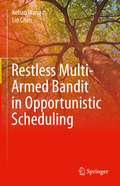- Table View
- List View
Responsive Security: Be Ready to Be Secure
by Meng-Chow KangResponsive Security: Be Ready to Be Secure explores the challenges, issues, and dilemmas of managing information security risk, and introduces an approach for addressing concerns from both a practitioner and organizational management standpoint. Utilizing a research study generated from nearly a decade of action research and real-time experience, this book introduces the issues and dilemmas that fueled the study, discusses its key findings, and provides practical methods for managing information security risks. It presents the principles and methods of the responsive security approach, developed from the findings of the study, and details the research that led to the development of the approach. Demonstrates the viability and practicality of the approach in today’s information security risk environment Demystifies information security risk management in practice, and reveals the limitations and inadequacies of current approaches Provides comprehensive coverage of the issues and challenges faced in managing information security risks today The author reviews existing literature that synthesizes current knowledge, supports the need for, and highlights the significance of the responsive security approach. He also highlights the concepts, strategies, and programs commonly used to achieve information security in organizations. Responsive Security: Be Ready to Be Secure examines the theories and knowledge in current literature, as well as the practices, related issues, and dilemmas experienced during the study. It discusses the reflexive analysis and interpretation involved in the final research cycles, and validates and refines the concepts, framework, and methodology of a responsive security approach for managing information security risk in a constantly changing risk environment.
Responsive Theming for Drupal: Making Your Site Look Good on Any Device
by Mike CrittendenIf you want your Drupal website to work well on smartphones, tablets, and desktops, this practical guide shows you how to incorporate Responsive Web Design (RWD) with specific Drupal 7 themes. You’ll learn how to create attractive, easy-to-navigate layouts for everything from tiny phone screens to 30-inch desktop monitors—all with the same codebase.Ideal for experienced Drupal developers, this book takes you through RWD basics and shows you how to build sites based on Aurora, Zen, and Omega—three popular base themes created by Drupal contributors. Whether you’re creating a new site with RWD or adapting an existing one, you’ll learn how to become a better, more efficient Drupal themer.Understand how Responsive Web Design and CSS media queries workLearn how the Sass stylesheet language and Compass framework support RWDAdopt a mobile-first approach to RWD—and learn why it’s importantGet step-by-step instructions for creating custom subthemes on top of Aurora, Zen, and OmegaTackle common problems when building and theming responsive Drupal sitesExplore alternative options for accommodating smartphone and tablet users
Responsive Typography: Using Type Well on the Web
by Jason PamentalResponsive web design helps your site maintain its design integrity on a variety of screen sizes, but how does it affect your typography? With this practical book, graphic designers, web designers, and front-end developers alike will learn the nuts and bolts of implementing web fonts well, especially how to get the best appearance from type without sacrificing performance on any device.After examining typography fundamentals and the evolution of type on the Web, author Jason Pamental provides useful approaches, real examples, code, and advice for making your type performant, progressive, proportional, and polished—the primary ingredients of responsive typography.Understand how type plays a vital role in content-first web designWeigh the tradeoffs between self-hosting and using a font service to get the best performance for your siteGet your type on the screen fast by designing for Progressive EnhancementUse a responsive relative scale to adjust proportions between typographic elements for any device or resolutionPolish your type with ligatures, kerning, and other techniques to create rich, textured reading experiences
Responsive Web Design (Brief Books for People Who Make Websites #4)
by Ethan MarcotteLearn how to think beyond the desktop and craft beautiful designs that anticipate and respond to your users' needs. The author will explore CSS techniques and design principles, including fluid grids, flexible images, and media queries, demonstrating how you can deliver a quality experience to your users no matter how large (or small) their display.
Responsive Web Design Patterns
by Chelsea MyersLearn how to build your own pattern library and fill it with the most popular responsive web design patterns About This Book * Explore the process of combining responsive patterns together to fit the needs of your own website or project * Organize your projects by creating responsive pattern libraries and manage unruly design systems as they grow * Break down the best responsive websites to their patterns and learn how to build them in your own projects Who This Book Is For This book is intended for HTML and CSS beginners who want to know where to start when creating a responsive website. It is also for more experienced developers who perhaps need a little inspiration for their next project. Knowing what makes a responsive site tick is not enough. You also have to know the best way to design a site that fulfills its required goals, shrinking and stretching to polar sizes all the while. This book aims to equip you with a foundation to do just that. What You Will Learn * Gain knowledge of the pros and cons of popular responsive patterns. * Build each pattern on your own using HTML, CSS, and JavaScript by following examples and guides provided in each chapter * Know how to combine patterns to create unique solutions for your own projects * Understand the benefits of creating a pattern library and learn how to use them efficiently * Pay attention to detail by reviewing commonly forgotten responsive elements such as typography * See real-world examples of these patterns being used by websites like Disney, NASA, and more * Review techniques and best practices when it comes to building responsive websites In Detail Responsive Web Design (RWD) is a web design approach aimed at arranging things in a way to get optimal viewing experience and easy reading and navigation on different screen sizes. It bonds together designers and developers as they publish and test new solutions to build websites for all screen sizes. The simplicity of this technology stems from the fact that learning about the most tested RWD solutions along with basic HTML, CSS, and a bit of JavaScript, can soon help you start using these solutions for yourself. The foundations of RWD, once mastered, will help you gain the skills you need to create your own responsive website. Keep track of Responsive Web Designs (RWD) patterns by building your own pattern library and creating RWD's most popular patterns, seen on hundreds of websites today. For beginners and pros, this book provides a toolset to help plan the design and functionality of a responsive website. The book begins with creating a home for all your patterns by setting up your own pattern library. Each chapter is broken down into different sections of a website; presenting patterns for each section. We move on to building responsive layouts of varying degrees of complexity to house the type of content you need. Develop menu systems and see which responsive navigation fits the size of your website. Next, you'll learn tactics to present media and data elegantly on different screen sizes. And finally, you'll tie up all those loose ends on your responsive website and pattern library to get it ready for launch. Style and approach This book is a collection of favored responsive patterns broken down to be easily understood and recreated. Each chapter focuses on a specific part of a website, from large to small, and shows you the markup and styles behind it. A responsive pattern library accompanies this book that you can download and see the patterns and your code beforehand.
Responsive Web Design Toolkit: Hammering Websites Into Shape
by Ken TaborResponsive Web Design Toolkit: Hammering Websites into Shape focuses on the nuts and bolts of responsive web design, showing you how to better build and how to debug websites that use the responsive technique. This book guides you through the technology that programmers use to build, test, and debug responsive websites. Covering what engineers do, how localhost can help, and DIY-testing, this book shows technically-minded designers how to create digital objects that lead to shorter development times, quicker testing cycles, and more insight into users and their mobile devices, ultimately leading to better products.
Responsive Web Design by Example
by Frahaan HussainDevelop mobile-first and adaptive websites that provide the best user experience for a wide range of devices About This Book • Rapidly develop and prototype responsive websites by leveraging the power of Bootstrap • Practice performance optimization techniques to make your site lighter and faster • Learn responsive web design and discover how to build mobile-ready websites with ease Who This Book Is For If you are a web developers interested in incorporating responsive web designs in your websites, then this book is for you. Familiarity with HTML5, CSS3, and command lines, though not essential, will help you get the most out of this book. What You Will Learn • Understand what responsive design is, and why it's vital for modern web development • Customize and extend responsive design frameworks • Create adaptable templates for all future projects • Build a semantic website structure with HTML5 elements • Determine a responsive website persona with CSS3 • Learn how to decide which framework best suits your project specification • Implement a plethora of Bootstrap features in your websites In Detail Desktop-only websites just aren't good enough anymore. As you enter a future of increasingly diverse browsing methods, you need to know how to build websites that are presentable and will work perfectly with the huge volume of different device sizes and resolutions that are now commercially available. Responsive web design is an answer to the problem of modern web development. By following the detailed step-by-step instructions, previews, and examples mentioned in this book, you will learn how to build engaging responsive websites and upgrade your skills as a web designer. With coverage of Responsive Grid System and Bootstrap, you will learn about the most powerful frameworks in responsive web design. In this book, you will learn how to create a crisp blog page, a beautiful portfolio site, a cool social networking page, and a fun photo gallery. Through each of these projects, you'll learn how to build various elements of a modern responsive website, and also find out which framework works best for your project specifications. By the end of the book, you will have gained practical skills you need to build real-world websites that are professional, creative and truly responsive. Style and approach This book conveys the design concepts used to quickly and effectively build responsive websites. We focus less on the theory and more on results, with clear step-by-step instructions, previews, and examples to help you along the way.
Responsive Web Design by Example
by Thoriq FirdausWritten as a concise yet practical guide with an explicit focus on showing beginners how to get their very own responsive websites up and running, this essential reference includes coverage of tried-and-tested responsive frameworks in a project-based format that simultaneously provides visible results whilst developing core understanding.Ideal for anybody who wants their online presence to be compatible with devices and resolutions of any size, "Responsive Web Design by Example" shows you how to select the right framework for your own project requirements and then guides you through the process of installation, configuration, and customization. With three highly structured and meticulously designed projects to choose from, it is the ideal reference for both new and existing web developers who want to be able to augment their skills and showcase their content in a truly professional manner.
Responsive Web Design by Example: Beginner's Guide - Second Edition
by Thoriq FirdausThis is the ideal reference for both new and existing web developers who want to be able to augment their skills and showcase their content in a truly professional manner.
Responsive Web Design with AngularJS
by Sandeep Kumar PatelIf you are an AngularJS developer who wants to learn about responsive web application development, this book is ideal for you. Responsive Web Design with AngularJS is intended for web developers or designers with a basic knowledge of HTML, CSS, and JavaScript.
Responsive Web Design with HTML5 and CSS3
by Ben FrainThis book will lead you, step by step and with illustrative screenshots, through a real example. Are you writing two websites - one for mobile and one for larger displays? Or perhaps you've heard of Responsive Design but are unsure how to bring HTML5, CSS3, or responsive design all together. If so, this book provides everything you need to take your web pages to the next level - before all your competitors do!
Responsive Web Design with HTML5 and CSS3 - Second Edition
by Ben FrainLearn the HTML5 and CSS3 you need to help you design responsive and future-proof websites that meet the demands of modern web users About This Book * Learn and explore how to harness the latest features of HTML5 in the context of responsive web design * Learn to wield the new Flexbox layout mechanism, code responsive images, and understand how to implement SVGs in a responsive project * Make your pages interactive by using CSS animations, transformations, and transitions Who This Book Is For Are you writing two websites - one for mobile and one for larger displays? Or perhaps you've already implemented your first 'RWD' but are struggling bring it all together? If so, Responsive Web Design with HTML5 and CSS3, Second Edition gives you everything you need to take your web sites to the next level. You'll need some HTML and CSS knowledge to follow along, but everything you need to know about Responsive Design and making great websites is included in the book! What You Will Learn * Understand what responsive design is, and why it's vital for modern web development * HTML5 markup is cleaner, faster, and more semantically rich than anything that has come before - learn how to use it and its latest features * Integrate CSS3 media queries into your designs to use different styles for different media. You'll also learn about future media queries which are evolving in CSS4. * Responsive images allow different images to be presented in different scenarios. We'll cover how to load different sets of images depending upon screen size or resolution and how to display different images in different contexts. * Conquer forms! Add validation and useful interface elements like date pickers and range sliders with HTML5 markup alone. * Implement SVGs into your responsive designs to provide resolution independent images, and learn how to adapt and animate them * Learn how to use the latest features of CSS including custom fonts, nth-child selectors (and some CSS4 selectors), CSS custom properties (variables), and CSS calc In Detail Desktop-only websites just aren't good enough anymore. With mobile internet usage still rising, and tablets changing internet consumption habits, you need to know how to build websites that will just 'work', regardless of the devices used to access them. This second edition of Responsive Web Design with HTML5 and CSS3 explains all the key approaches necessary to create and maintain a modern responsive design. The changing way in which we access the web means that there has never been a greater range of screen sizes and associated user experiences to consider. With these recent trends driving changes in design, typical desktop-only websites fail to meet even minimum expectations when it comes to style and usability, which can be vital when your website is central to yours or your client's brand. Responsive Web Design with HTML5 and CSS3, Second Edition is an updated and improved guide that responds to the latest challenges and trends in web design, giving you access to the most effective approaches to modern responsive design. Learn how to build websites with a "responsive and mobile first" methodology, allowing a website to display effortlessly on every device that accesses it. Packed with examples, and a thorough explanation of modern techniques and syntax, Responsive Web Design with HTML5 and CSS3, Second Edition provides a comprehensive resource for all things 'responsive'. This updated new edition covers all the most up-to-date techniques and tools needed to build great responsive designs, ensuring that your projects won't just be built 'right' for today, but in the future too. Chapter example code is all hosted on rwd.education, a dedicated site for the book, built by the author, using the approaches and techniques championed throughout.
Responsive Web Design with HTML5 and CSS3 Essentials
by Alex Libby Gaurav Gupta Asoj TalesraDesign and deliver an optimal user experience for all devices About This Book * Get to grips with the core functionality of RWD through examples * Discover how to make layouts, content and media flexible, and explore why a content-first approach is more effective * Maximize the performance of your web pages so that they work across all browsers and devices irrespective of the screen size Who This Book Is For This book is for web designers who are familiar with HTML and CSS, and want to begin with responsive web design. Web development experience and knowledge of HTML5, CSS3 is assumed. What You Will Learn * Explore various layout options * Understand what can be achieved in the browser, without the use of third-party tools * Executing media queries to benefit responsive designs * Understand the basics of responsive workflow and boilerplate frameworks * Improve performance of responsive web design * Maintain compatibility across various browsers In Detail Responsive web design (RWD) is a web design approach aimed at crafting sites to provide an optimal viewing and interaction experience--providing easy reading and navigation with minimum resizing, panning, and scrolling--and all of this across a wide range of devices from desktop computer monitors to mobile phones. Responsive web design is becoming more important as the amount of mobile traffic now accounts for more than half of the Internet's total traffic. This book will give you in depth knowledge about the basics of responsive web design. You will embark on a journey of building effective responsive web pages that work across a range of devices, from mobile phones to smart TVs, with nothing more than standard markup and styling techniques. You'll begin by getting an understanding of what RWD is and its significance to the modern web. Building on the basics, you'll learn about layouts and media queries. Following this, we'll dive into creating layouts using grid based templates. We'll also cover the important topic of performance management, and discover how to tackle cross-browser challenges. Style and approach This is a practical example-based book which will delve into various elements and benefits of a responsive web design. It will help you understand the essential skills needed to create responsive web sites and guide you through the basics of building responsive web pages for any device. The topics are a blend of theoretical and practical essentials which will assist you to explore more about responsive web design.
Responsive Web Design with HTML5 and CSS: Build future-proof responsive websites using the latest HTML5 and CSS techniques
by Ben FrainHarness the latest capabilities of HTML5 and CSS to create a single UI that works flawlessly on mobile phones, tablets, and desktops — plus everything in-between – now with color images! Purchase of the print or Kindle book includes a free eBook in PDF format.Key FeaturesUnderstand what responsive web design is and its significance for modern web developmentExplore the latest developments in responsive web design and CSS, including layout with Grid and Subgrid, CSS Cascade Layers, Wide Gamut colors, and CSS FunctionsGet to grips with the uses and benefits of new HTML elements and attributesBook DescriptionResponsive Web Design with HTML5 and CSS, Fourth Edition, is a fully revamped and extended version of one of the most comprehensive and bestselling books on the latest HTML5 and CSS techniques for responsive web design. It emphasizes pragmatic application, teaching you the approaches needed to build most real-life websites, with downloadable examples in every chapter. Written in the author's friendly and easy-to-follow style, this edition covers all the newest developments and improvements in responsive web design, including approaches for better accessibility, variable fonts and font loading, and the latest color manipulation tools making their way to browsers. You can enjoy coverage of bleeding-edge features such as CSS layers, container queries, nesting, and subgrid. The book concludes by exploring some exclusive tips and approaches for front-end development from the author. By the end of the book, you will not only have a comprehensive understanding of responsive web design and what is possible with the latest HTML5 and CSS, but also the knowledge of how to best implement each technique. Read through as a complete guide or dip in as a reference for each topic-focused chapter.What you will learnUse media queries, including detection for touch/mouse and color preferenceLearn HTML semantics and author accessible markupFacilitate different images depending on screen size or resolutionWrite the latest color functions, mix colors, and choose the most accessible onesUse SVGs in designs to provide resolution-independent imagesCreate and use CSS custom properties, making use of new CSS functions including ‘clamp', ‘min', and ‘max'Add validation and interface elements to HTML formsEnhance interface elements with filters, shadows, and animationsWho this book is forAre you a full-stack or back-end developer who needs to improve their front-end skills? Perhaps you work on the front-end and you need a definitive overview of all modern HTML and CSS has to offer? Maybe you have done a little website building but you need a deep understanding of responsive web designs and how to achieve them? This is the book for you! All you need to take advantage of this book is a working understanding of HTML and CSS. No JavaScript knowledge is needed.
Responsive Web Design with HTML5 and CSS: Build future-proof responsive websites using the latest HTML5 and CSS techniques, 4th Edition
by Ben FrainHarness the latest capabilities of HTML5 and CSS to create a single UI that works flawlessly on mobile phones, tablets, and desktops — plus everything in-between – now with color images!Key FeaturesUnderstand what responsive web design is and its significance for modern web developmentExplore the latest developments in responsive web design and CSS, including layout with Grid and Subgrid, CSS Cascade Layers, Wide Gamut colors, and CSS FunctionsGet to grips with the uses and benefits of new HTML elements and attributesBook DescriptionResponsive Web Design with HTML5 and CSS, Fourth Edition, is a fully revamped and extended version of one of the most comprehensive and bestselling books on the latest HTML5 and CSS techniques for responsive web design. It emphasizes pragmatic application, teaching you the approaches needed to build most real-life websites, with downloadable examples in every chapter.Written in the author's friendly and easy-to-follow style, this edition covers all the newest developments and improvements in responsive web design, including approaches for better accessibility, variable fonts and font loading, and the latest color manipulation tools making their way to browsers. You can enjoy coverage of bleeding-edge features such as CSS layers, container queries, nesting, and subgrid.The book concludes by exploring some exclusive tips and approaches for front-end development from the author.By the end of the book, you will not only have a comprehensive understanding of responsive web design and what is possible with the latest HTML5 and CSS, but also the knowledge of how to best implement each technique. Read through as a complete guide or dip in as a reference for each topic-focused chapter.What you will learnUse media queries, including detection for touch/mouse and color preferenceLearn HTML semantics and author accessible markupFacilitate different images depending on screen size or resolutionWrite the latest color functions, mix colors, and choose the most accessible onesUse SVGs in designs to provide resolution-independent imagesCreate and use CSS custom properties, making use of new CSS functions including clamp', min', and max'Add validation and interface elements to HTML formsEnhance interface elements with filters, shadows, and animationsWho this book is forAre you a full-stack or back-end developer who needs to improve their front-end skills? Perhaps you work on the front-end and you need a definitive overview of all modern HTML and CSS has to offer? Maybe you have done a little website building but you need a deep understanding of responsive web designs and how to achieve them? This is the book for you! All you need to take advantage of this book is a working understanding of HTML and CSS. No JavaScript knowledge is needed.
Responsive Web Design with HTML5 and CSS: Develop future-proof responsive websites using the latest HTML5 and CSS techniques, 3rd Edition
by Ben FrainHarness the latest capabilities of HTML5 and CSS to create a single UI that works flawlessly on mobile phones, tablets, and desktops — plus everything in-between Key Features Understand what responsive web design is and its significance for modern web development Explore the latest developments in responsive web design including variable fonts, CSS Scroll Snap, and more Get to grips with the uses and benefits of the new CSS Grid layout Book Description Responsive Web Design with HTML5 and CSS, Third Edition is a renewed and extended version of one of the most comprehensive and bestselling books on the latest HTML5 and CSS tools and techniques for responsive web design. Written in the author's signature friendly and informal style, this edition covers all the newest developments and improvements in responsive web design including better user accessibility, variable fonts and font loading, CSS Scroll Snap, and much, much more. With a new chapter dedicated to CSS Grid, you will understand how it differs from the Flexbox layout mechanism and when you should use one over the other. Furthermore, you will acquire practical knowledge of SVG, writing accessible HTML markup, creating stunning aesthetics and effects with CSS, applying transitions, transformations, and animations, integrating media queries, and more. The book concludes by exploring some exclusive tips and approaches for front-end development from the author. By the end of this book, you will not only have a comprehensive understanding of responsive web design and what is possible with the latest HTML5 and CSS, but also the knowledge of how to best implement each technique. What you will learn Integrate CSS media queries into your designs; apply different styles to different devices Load different sets of images depending upon screen size or resolution Leverage the speed, semantics, and clean markup of accessible HTML patterns Implement SVGs into your designs to provide resolution-independent images Apply the latest features of CSS like custom properties, variable fonts, and CSS Grid Add validation and interface elements like date and color pickers to HTML forms Understand the multitude of ways to enhance interface elements with filters, shadows, animations, and more Who this book is for Are you a full-stack developer who needs to gem up on his front-end skills? Perhaps you work on the front-end and you need a definitive overview of all modern HTML and CSS has to offer? Maybe you have done a little website building but you need a deep understanding of responsive web designs and how to achieve them? This is a book for you! All you need to take advantage of this book is a working understanding of HTML and CSS. No JavaScript knowledge is needed.
Responsive Web Design with jQuery
by Gilberto Crespo"Responsive Web Design with jQuery" follows a standard tutorial-based approach, covering various aspects of responsive web design by building a comprehensive website."Responsive Web Design with jQuery" is aimed at web designers who are interested in building device-agnostic websites. You should have a grasp of standard HTML, CSS, and JavaScript development, and have a familiarity with graphic design. Some exposure to jQuery and HTML5 will be beneficial but isn't essential.
Responsive and Sustainable Educational Futures: 18th European Conference on Technology Enhanced Learning, EC-TEL 2023, Aveiro, Portugal, September 4–8, 2023, Proceedings (Lecture Notes in Computer Science #14200)
by Pedro J. Muñoz-Merino Olga Viberg Ioana Jivet Maria Perifanou Tina PapathomaThis book constitutes the proceedings of the 18th European Conference on Technology Enhanced Learning, EC-TEL 2023, held in Aveiro, Portugal, in September 2023.The 34 full papers included in this volume were carefully reviewed and selected from 126 submissions. Additionally, 24 posters and 16 demonstration papers were included in the proceedings. The papers focus on sustainable teaching and learning practices in the post-pandemic educational ecosystem.
Responsywne i wydajne projekty internetowe. Szybkie aplikacje dla ka?dego
by Tom BarkerSuperwydajne aplikacje i strony WWW!1024×768, 800×600 — czy te liczby co? Ci mówi?? To najpopularniejsze rozdzielczo?ci ekranu, które obowi?zywa?y w czasach przed mobiln? rewolucj?. Obecnie u?ytkownicy korzystaj? z przeró?nych ekranów, wy?wietlaj?cych obrazy w wielu innych rozdzielczo?ciach. Jak sobie z tym poradzi?? Jak tworzy? strony WWW, które b?d? dzia?a? poprawnie na ka?dym dost?pnym urz?dzeniu? Jak rozwi?za? problemy z wydajno?ci?? Na te i dziesi?tki innych pyta? odpowiada ta niezwyk?a ksi??ka.Si?gnij po ni? i zapoznaj si? z najnowszymi trendami w tworzeniu responsywnych i wydajnych stron WWW oraz aplikacji internetowych. W trakcie lektury zdob?dziesz bezcenn? wiedz? na temat mierzenia wydajno?ci aplikacji oraz czynników, które maj? na ni? wp?yw. Kolejne rozdzia?y dostarcz? Ci wyczerpuj?cych informacji dotycz?cych ciekawych rozwi?za? problemu wydajno?ci po stronie klienta oraz serwera, a ponadto zaprezentuj? techniki ci?g?ego testowania wydajno?ci. Przekonaj si?, jak istotne jest zapewnianie obrazów dopasowanych do urz?dzenia oraz stosowanie pami?ci podr?cznej. Poznaj dost?pne responsywne szkielety oraz ich ocen? wed?ug osobistych kryteriów autora. Jest to doskona?a lektura dla wszystkich osób pod??aj?cych za trendami w tworzeniu stron WWW i aplikacji internetowych. Uzyskaj podstawowe informacj? dotycz?ce wydajno?ci stron i narz?dzi do jej mierzenia. Pisz funkcjonalno?ci przy wykorzystaniu NodeJS, które zaserwuj? zasoby przystosowane do urz?dzenia klienta. Poznaj rozwi?zania dzia?aj?ce po stronie klienta, takie jak leniwe ?adowanie ca?ych sekcji strony — w??cznie z obrazami, stylami i zawarto?ci?. Sprawdzaj zgodno?? z umow? SLA poprzez automatyczne testy napisane w PhantomJS. Przeanalizuj kilka responsywnych frameworków, oraz autorski framework Toma Barkera dzia?aj?cy po stronie serwera.Poznaj sposoby tworzenia wydajnych i responsywnych aplikacji internetowych!Tom Barker — jest zwi?zany z wytwarzaniem oprogramowania od lat 90. XX wieku. Aktualnie pe?ni funkcj? dyrektora ds. wytwarzania oprogramowania w firmie Comcast. Interesuje si? analiz? danych i ich wizualizacj?. Szczególn? uwag? przyk?ada do tworzenia kodu wysokiej jako?ci.
Responsywne strony WWW dla ka_dego
by Clarissa PetersonTwórz skalowalne strony WWW (RWD) dla wszystkich urz?dze?!Responsywne strony WWW umiej?tnie dostosowuj? si? do rozmiaru ka?dego ekranu, na jakim zechcesz je wy?wietli?. Ta ich w?a?ciwo?? pomaga równie? generowa? zyski! Po pierwsze, wystarczy utrzymywa? tylko jedn? wersj? responsywnej strony. Po drugie, Twoi potencjalni klienci i u?ytkownicy mog? zapozna? si? z Twoj? ofert? lub skorzysta? z niej praktycznie w dowolnym miejscu ?wiata. I to niezale?nie od tego, czy korzystaj? ze smartfona, z tabletu czy z komputera stacjonarnego!Je?eli chcesz nauczy? si? tworzy? takie strony, ta ksi??ka b?dzie dla Ciebie najlepszym ?ród?em! Ju? za chwil? dowiesz si?, w jaki sposób zbudowa? skalowalne strony WWW z wykorzystaniem najnowszych mo?liwo?ci kaskadowych arkuszy stylów CSS3 oraz j?zyka HTML5. Przekonasz si?, jak ?atwo mo?esz modyfikowa? style pod konkretne media oraz jak najlepiej zorganizowa? proces projektowania responsywnej strony WWW. Zaznajomisz si? te? z najlepszymi technikami poprawy wydajno?ci Twoich stron WWW. To jest obowi?zkowa lektura dla wszystkich programistów i projektantów stron WWW! Przygotuj strategi? tre?ci strony zanim zajmiesz si? jej wizualnym wygl?dem Dowiedz si?, dlaczego domy?lnym wzorcem powinna by? strona przystosowana do ma?ych ekranów Poznaj elementy j?zyka HTML i w?a?ciwo?ci stylów CSS niezb?dne do tworzenia skalowalnych stron Zastosuj zapytania o media, aby wy?wietla? ró?ne style CSS na ekranach ró?nej wielko?ci Modyfikuj obrazy, czcionki i sekcje nawigacji Stosuj techniki optymalizacyjne, aby tworzy? mniejsze i szybsze stronyOdkryj mo?liwo?ci responsywnych stron WWW!
Responsywne strony WWW. Technologia na start!
by Andrew Fisher Craig SharkieStrony WWW dla ka?dego urz?dzenia!Responsywne strony WWW potrafi? dopasowywa? si? do rozmiaru ekranu u?ytkownika. Niezale?nie od tego, czy korzysta on ze stacjonarnego komputera z du?ym monitorem, laptopa czy smartfona, zawsze mo?e bez utraty kluczowej zawarto?ci przegl?da? ulubione witryny. Responsywno?? by?a do niedawna tylko dodatkiem do tworzonych stron — mia?a po prostu mi?o zaskoczy? klientów. Obecnie to standard us?ug WWW.Z tej unikalnej ksi??ki dowiesz si?, jak sprawnie tworzy? responsywne serwisy. Nauczysz si? stosowa? p?ynne siatki oraz korzysta? z tych gotowych: 960 Grid System, 320 and Up oraz Bootstrap. Zrozumiesz, w jaki sposób dzia?aj? responsywne strony, które nie tylko dostosowuj? swój uk?ad do rozmiaru ekranu, lecz tak?e adaptuj? dostarczane materia?y multimedialne, g?ównie zdj?cia. W kolejnych rozdzia?ach znajdziesz obszerne omówienie tych zagadnie?. W ko?cu dowiesz si?, jak stworzy? w?asny elastyczny szablon oraz jakie s? dost?pne gotowe rozwi?zania. Ta ksi??ka jest obowi?zkow? lektur? ka?dego dewelopera stron WWW, który chce by? na czasie oraz korzysta? z dobrodziejstw responsywnych stron!Dzi?ki tej ksi??ce: poznasz potencja? responsywnych stron WWW stworzysz w?asn? p?ynn? siatk? zaserwujesz u?ytkownikowi pliki multimedialne dostosowane do jego urz?dzenia poznasz szablony — Bootstrap, Foundation, Skeleton i inne zbudujesz responsywn? stron?Obowi?zkowa lektura ka?dego dewelopera stron WWW!
Ressourceneffiziente Selbstoptimierende Wäscherei: Ergebnisse des ReSerW-Projekts (Intelligente Technische Systeme – Lösungen aus dem Spitzencluster it’s OWL)
by Ansgar TrächtlerDie Publikation befasst sich mit der Optimierung einer Wäscherei hinsichtlich ihrer Ressourceneffizienz. Ressourcen umschließen hierbei die menschliche Arbeitskraft, der Umsatz von Chemikalien und Wasser, sowie den Energieverbrauch. Die Grundlagen der Wäschereitechnik und die eingesetzten wissenschaftlichen Methoden bilden die Grundlage für die exemplarische Umsetzung einer ressourceneffizienten Wäscherei. Diese Umsetzung erfolgt in vier Pilotprojekten, die sich mit unterschiedlichen aktuellen Herausforderungen der Wäschereitechnik beschäftigten.Ergebnisse des ReSerW-Projekts im Rahmen des Spitzenclusters intelligente technische Systeme OWL (it’s OWL).
RestKit for iOS
by Taras KalapunA step-by-step, example-based guide to learning how you can link your apps and web services using RestKit.This book is for iOS developers of all levels who are interested in boosting their productivity by utilizing third party libraries and who have a willingness to learn how to build RESTful apps using the RestKit framework. A basic knowledge of Objective-C is required as well as a simple understanding of how to use CoreData.
Restful API Design (API University Series)
by Matthias BiehlLooking for Best Practices for RESTful APIs? This book is for you! Why? Because this book is packed with practical experience on what works best for RESTful API Design. You want to design APIs like a Pro? Use API description languages to both design APIs and develop APIs efficiently. The book introduces the two most common API description languages RAML, OpenAPI, and Swagger. Your company cares about its customers? Learn API product management with a customer-centric design and development approach for APIs. Learn how to manage APIs as a product and how to follow an API-first approach. Build APIs your customers love! You want to manage the complete API lifecycle? An API development methodology is proposed to guide you through the lifecycle: API inception, API design, API development, API publication, API evolution, and maintenance. You want to build APIs right? This book shows best practices for REST design, such as the correct use of resources, URIs, representations, content types, data formats, parameters, HTTP status codes, and HTTP methods. Your APIs connect to legacy systems? The book shows best practices for connecting APIs to existing backend systems. Your APIs connect to a mesh of microservices? The book shows the principles for designing APIs for scalable, autonomous microservices. You expect lots of traffic on your API? The book shows you how to achieve high performance, availability and maintainability. You want to build APIs that last for decades? We study API versioning, API evolution, backward- and forward-compatibility and show API design patterns for versioning. The API-University Series is a modular series of books on API-related topics. Each book focuses on a particular API topic, so you can select the topics within APIs, which are relevant for you.
Restless Multi-Armed Bandit in Opportunistic Scheduling
by Lin Chen Kehao WangThis book provides foundations for the understanding and design of computation-efficient algorithms and protocols for those interactions with environment, i.e., wireless communication systems. The book provides a systematic treatment of the theoretical foundation and algorithmic tools necessarily in the design of computation-efficient algorithms and protocols in stochastic scheduling. The problems addressed in the book are of both fundamental and practical importance. Target readers of the book are researchers and advanced-level engineering students interested in acquiring in-depth knowledge on the topic and on stochastic scheduling and their applications, both from theoretical and engineering perspective.
